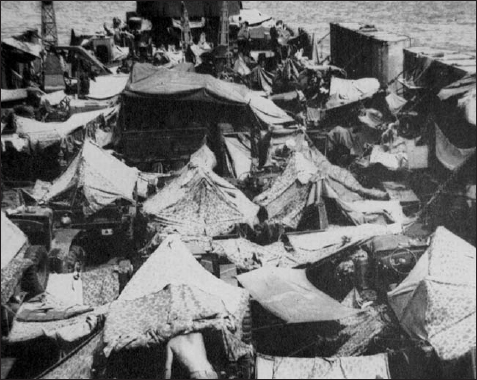
Marine V Amphibious Corps (VAC) was assigned responsibility for Operation “Forager”, the US assault on the Marianas, on 15 January 1944. The tempo of Allied operations increased markedly following the neutralization of Truk and, on 13 March, Admiral Nimitz gave orders that Forager’s planning be given the highest priority.
The Japanese defense of the Marianas focused on the five largest islands, which were held in strength. Saipan, the second largest island, was the main Japanese stronghold and the US Command decided this would be assaulted first on 15 June, with Tinian to follow on an unspecified date. The assault on Guam (W-Day3) was provisionally set for 18 June, but the actual date would be finalized based on the tactical situation. It was decided to bypass the islands of Rota and Pagan.
Prior to seizing Guam (code-named “Stevedore”), VAC would secure Saipan and begin construction of the B-29 airbases as early as possible. To seize Guam, III Amphibious Corps (IIIAC)4 was assigned the 3rd Marine Division (MarDiv), 1st Provisional Marine Brigade (Prov MarBde), 77th Infantry Division (InfDiv), and IIIAC Artillery. VAC was designated the Northern Troops and Landing Force (NTLF) while IIIAC was the Southern Troops and Landing Force (STLF). Lieutenant General Holland M. Smith, Commanding General, VAC, was designated Commanding General, Expeditionary Troops with authority over both NTLF and STLF.
Planning guides were prepared by higher headquarters and provided to IMAC (IIIAC) on 30 March. The Corps submitted a tentative plan on 3 April, which was approved by LtGen Smith and then the navy commanders. IMAC was headquartered on Guadalcanal at the time, as was the 3rd MarDiv. The 1st Prov MarBde was in the process of forming and its subordinate units would be transferred to Guadalcanal to allow planning, training, and rehearsals with the Corps. Expeditionary Troops and VAC were in Hawaii. The staff of the Southern Attack Force (Task Force TF 53), the naval force that would deliver and support STLF, arrived at Guadalcanal to expedite planning and coordination on 15 April. Most of the ships that would comprise TF 53 were still off New Guinea where they had supported the Hollandia landing. Most had arrived in the Solomons in May for repairs and replenishing.

Marines en route to Guam on a landing ship tank, (LST), or “large slow target,” camped out on the deck to avoid the ship’s sweltering interior. Camouflage shelter halves (“pup tents”), ponchos, and canvas traps give the deck the appearance of a floating hobo camp.
“Forager” was a complex operation with two major landing forces tasked with securing three different islands. It was foreseen the Guam assault would probably be delayed depending on developments on Saipan. NTLF would initially be the lead force. Its success on Saipan would dictate all subsequent operations along with the employment of the reserve and STLF with the latter also serving as a reserve for the NTLF until 25 June. The 77th InfDiv initially remained in Hawaii as the Area Reserve.
In the intelligence arena the capture of 31st Army documents on Saipan provided a great deal of information on Japanese forces on Guam. In late May the US estimate of Japanese strength on Guam was 10,100–11,800. On 18 July this was revised to 18,657 Imperial Japanese Army and Navy personnel.
A unique aspect of the STLF plan was that the two landing forces would be separated by almost 7 miles (11km). It was unprecedented for two landing forces to land with such a wide separation. The Army had recently landed two divisions at Hollandia on New Guinea separated by 25 miles, but for all practical purposes these were two separate operations. There was no expectation for early link-up and the goal was to entrap the Japanese in a double-envelopment. It also allowed for one of the forces being delayed by enemy action or difficult terrain. The calculated risk taken on Guam was justifiable because of the location of suitable landing beaches and the fact that the bulk of the Japanese forces were positioned at and between the two beaches. This risk was necessary because they were the only suitable beaches on the cliff-lined island. One of the landing’s key initial goals, besides establishing forces ashore and inflicting an early beating on the main defending forces, was to secure Apra Harbor. The northern force would secure the immediate harbor area while the southern force cleared the dominating Orote Peninsula, control of which was vital to allow use of the harbor.
The 3rd MarDiv would land on the Northern or Asan Beaches situated between Adelup and Asan Points, both Japanese strongpoints. These beaches totaled only about 2,500 yards (2286m) in width. Asan Town was dead in the center of the beaches. All three regiments would land abreast, with only 1/9 Marines serving as a Reserve as the Division relied on the Corps Reserve. Overlooking the beaches was Bundschu Ridge5 on the edge of Fonte Plateau. The 3rd Marines would secure Adelup Point and seize Bundschu Ridge. The 21st Marines in the center would push inland up the two branches of the Asan River. The 9th Marines would seize Asan Point and push toward Apra Harbor.
The 1st Prov MarBde would assault the Southern or Agat Beaches. These were in Agat Bay south of Orote Peninsula and overlooked by the 869ft (265m) Mt. Alifan. The rice paddies behind the beaches disappeared as the ground rose towards Mt. Alifan. The 22nd Marines would swing north toward Orote Peninsula. The 4th Marines would both secure the south flank on Bangi Point and block Harmon Road. The 4th Marines would be followed ashore by the 305th Infantry landing on order. The 305th would takeover the defense of the Force Beachhead Line (FBL) from the Brigade, secure the high ground above the beaches, and extend the beachhead south. The Brigade would then make a concerted effort to seize Orote Peninsula. IIIAC Artillery would land on the Southern Beaches to provide fire support to the north.
The remainder of the 77th InfDiv initially served as the STLF Reserve. The Expeditionary Troops Floating Reserve was the 26th Marines (Reinforced) with 1/13 Marines [artillery], detached from the 5th MarDiv still in the States. The latter was sent to Hawaii at the end of July as it was not needed.
IIIAC conducted training and rehearsals at Guadalcanal, but the 77th InfDiv, still in Hawaii, could not take part. On 1 June units began departing for Kwajalein, and then on to the Saipan area on the 12th arriving on the 16th. They remained there until the 25th at which time the 3rd MarDiv was sent to Eniwetok. The 1st Prov MarBde remained on station until the 30th and then returned to Kwajalein.
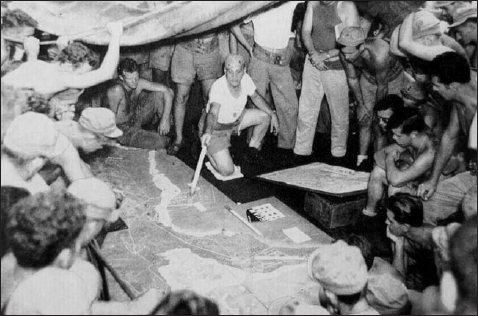
Artillerymen of Howitzer Battalion, 22nd Marines, 1st Prov MarBde, are briefed on a Guam terrain board by the Bn-2 (intelligence officer) while en route to Guam. He is pointing to the Southern Beaches where they will follow their regiment ashore.
While the assault on Guam was tentatively scheduled for 18 June, it was delayed by over a month for several reasons. It was discovered that the 1st Mobile Fleet was approaching the Marianas from the Philippines at that time and the landing was postponed so as not to endanger the Southern Attack Force en route to Guam. With the battle of the Philippine Sea over, another delay was imposed because of the stronger than expected resistance on Saipan. This required that the Expeditionary Troops Reserve, the 27th InfDiv, be committed. Fearing additional reinforcement might be required on Saipan; the 1st Prov MarBde was retained in the area as the Expeditionary Troops Reserve.
In the meantime it was decided to release the General Reserve at Hawaii, the 77th InfDiv, to the STLF on 6 July for use on Guam. The entire division could not deploy immediately because the necessary transports were still at Saipan. However, on 30 June it was decided the landing should not be attempted until the entire 77th was on-station. W-Day was reset for 25 July. When it was learned that the Division would be assembled at Eniwetok in its entirety by the 18th, W-Day was moved forward to 21 July.
Following the loss of most of eastern New Guinea and the Solomon Islands, in September 1943 the Imperial General Headquarters established the National Defense Zone, known to the Allies as the “Tojo Line”. With the capture of Kwajalein in February, the Imperial Japanese Navy expected an assault on the Marianas by the end of March. By April the Admiralty Islands had fallen, and both Truk and the Marshalls had been neutralized. The IJN belief, reinforced by the continued advance westward of MacArthur’s forces along the north New Guinea coast, was that the next strike would be in the Palaus or elsewhere in the Western Carolines. Although the Imperial Japanese Army made some efforts to reinforce the Marianas in March, it would be May before the bulk of the units arrived; less than two months before the invasion. In June orders were issued (but never executed) for some IJA personnel to transfer from the Marianas to the Palaus; a result of the IJA conviction that the Palaus were now the most likely target of an American attack
The Imperial General Headquarters issued plans for Operation A-Go on 3 May 1944, and the Combined Fleet prepared to face the invading US Fleet in a decisive engagement in the Palaus-Carolines area. In this it would be supported by land-based IJN and IJA aircraft in the Philippines, Carolines, Palaus, and Marianas, and in June more than 500 additional land-based aircraft deployed to the Mandate. After it withdrew from Truk, the Combined Fleet was based at Tawitawi Island off the northeast tip of Borneo, allowing it to sail south of the Philippines or direct to the Palaus or Western Carolines. The southern Marianas were some considerable distance further from Tawitawi, however, and fuel was in short supply.
The US had carried out no major operations in the Central Pacific since February, and by the beginning of June Imperial General Headquarters was expecting some move in this theater. However, on 27 May MacArthur’s forces had landed on Biak, only 800 miles (1,288km) from the southern Philippines and it was possible this might now be the main Allied thrust. As a result many of Guam’s aircraft were sent to Biak, and few returned.
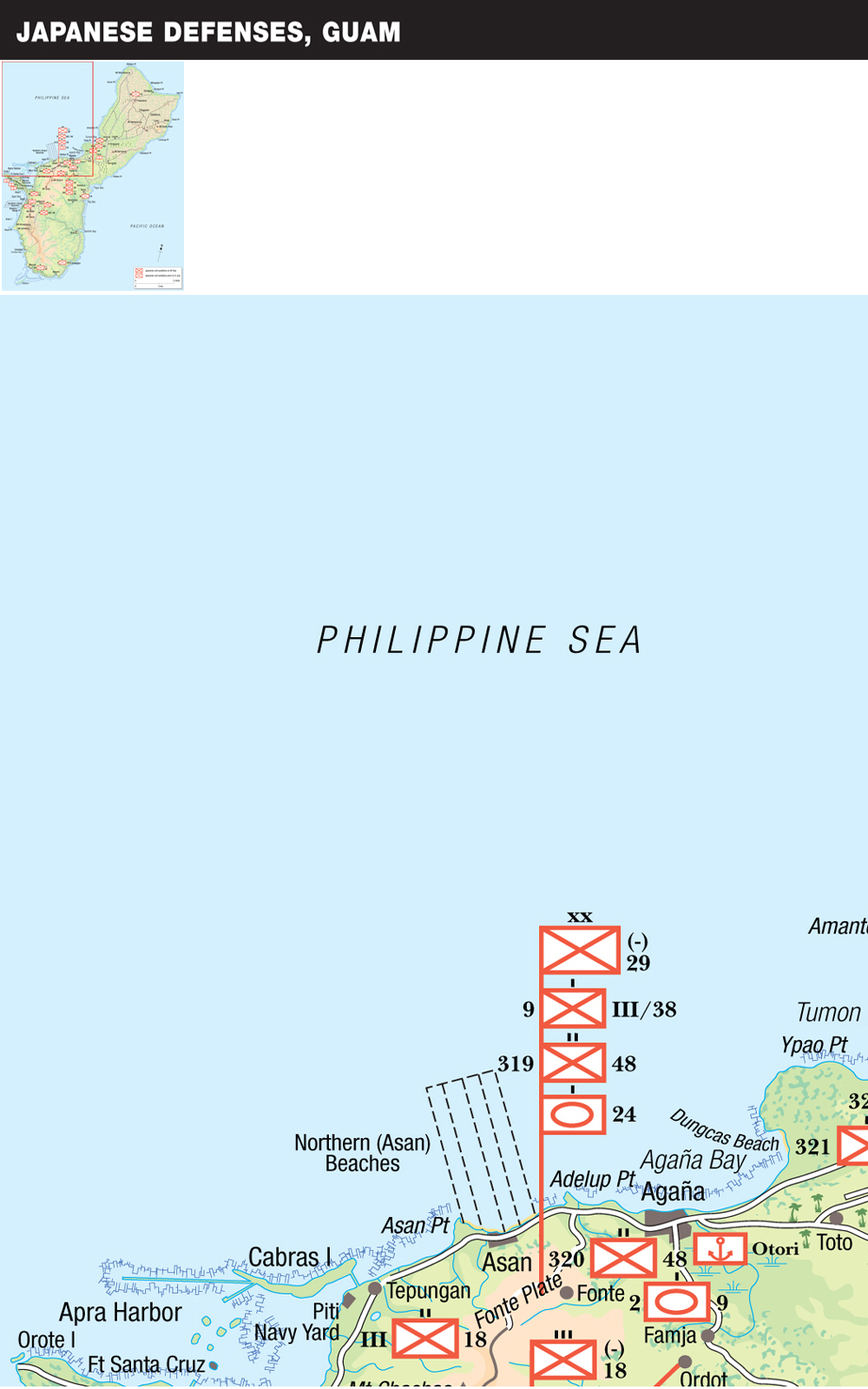
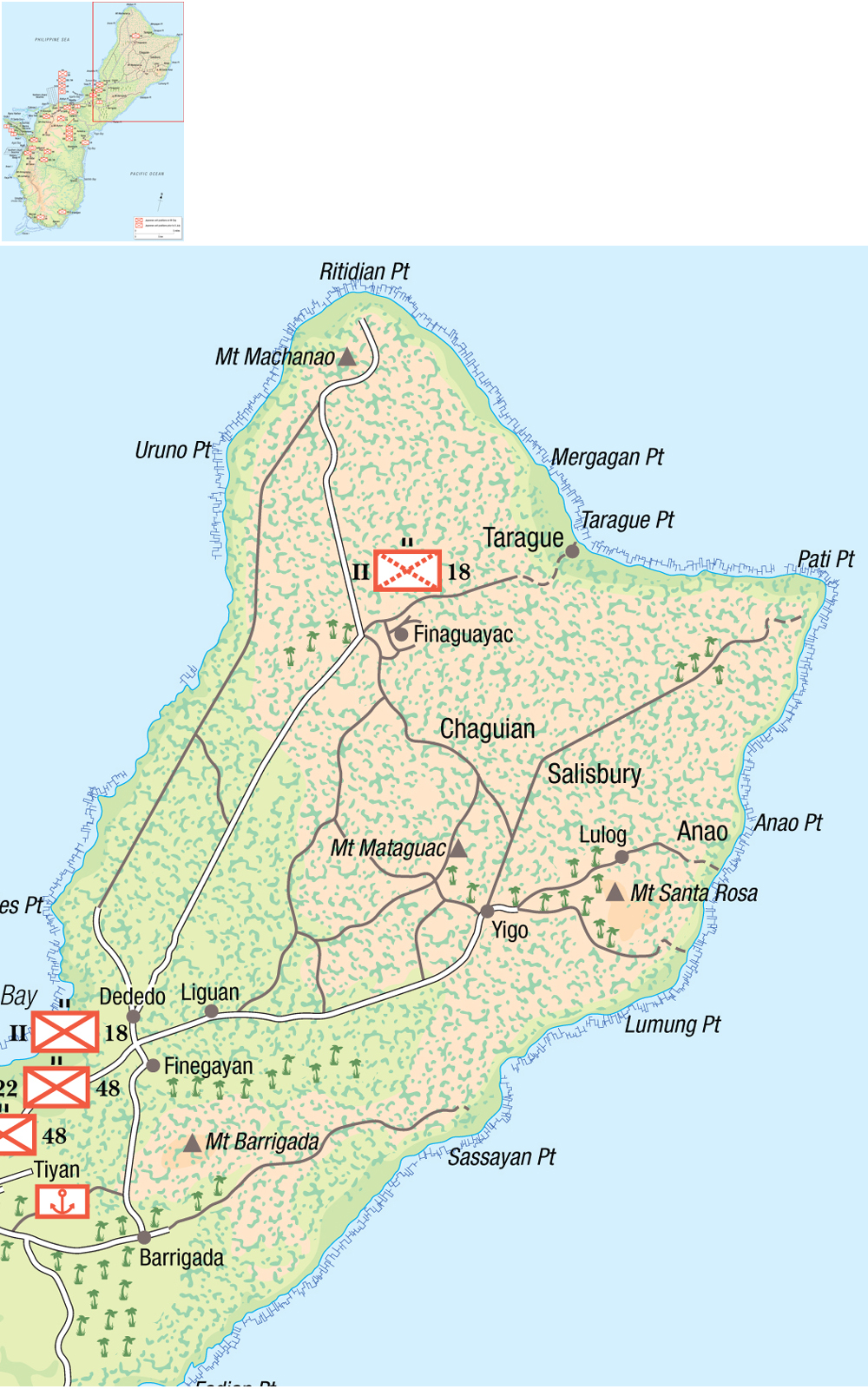


Before 10 March 1944 the 4th Fleet had been solely responsible for the defense of the Mandates, but on this date IJN established the Central Pacific Area Fleet. This new command oversaw the Volcano and Bonin Islands, Marianas, and Western Carolines and 4th Fleet was subordinate to it, retaining direct control over Truk, the Eastern Carolines, and those islands in the Marshalls bypassed by the Allied advance. In theory, the Central Pacific Area Fleet was also to have control of IJA units in the area, but 31st Army, headquartered on Saipan, refused subordination to the IJN. In mid-March a dreadful compromise solution was reached by which each island was commanded by the senior IJA or IJN commander present. Neither 31st Army or Central Pacific Area Fleet would assume overall authority of the area, with the result that there was no unified Japanese command in the Central Pacific.
In previous US assaults on islands in the Central Pacific Theater, the Japanese had defended the beaches, intending to destroy the landing force at the water’s edge. These had, however, mainly been very small atoll islands with no space for multiple lines of defense or reserves to maneuver and artillery placed on the shoreline. An airfield often occupied the bulk of the island, and there were seldom the dominating terrain features necessary to establish in-depth defenses.
The hilly islands of the Marianas were considerably larger allowing the creation of multiple lines of defense. Although strongpoints could be sited on key terrain features, and there was sufficient room for reserves to maneuver and counterattack, the Japanese proved unable to capitalize on these various advantages.
The IJN 54th Guard Force with its coast defense and antiaircraft guns was able to encase many in reinforced concrete positions, but other positions were uncompleted. Sizable IJA forces had arrived in March giving them over four months to prepare. One final advantage enjoyed by Guam’s Japanese defenders was an additional 35 days after the Saipan attack began to prepare for the inevitable assault. This was somewhat negated by the paucity of construction materials.
Many Japanese units had suffered heavily from the attentions of the US submarine force even before they reached the islands, losing weapons, essential equipment, and much of their unit cohesion. This was particularly true of the 29th Division: its 18th Infantry had lost many troops and most of its equipment. Although the regiment was partly rebuilt, its 50th Infantry ended up on Tinian and an additional battalion was diverted to Saipan. On its arrival, all IJN units on Guam were placed under 29th Division control, which doubled as the Southern Marianas Army Group and, in this capacity, was also responsible for Rota.
I/10 Independent Mixed Regiment (IMR) was deployed to Rota. A few days later III/18 Infantry followed to provide amphibious reinforcement for Guam. Rough seas, which led to the loss of 100 men and two landing barges, and the high probability that the force would be interdicted, resulted in the battalion being returned to Guam for more practical employment. Time for preparations was running out and the Japanese concentrated on fortifying the high ground overlooking the most likely landing beaches. The landward neck of Orote Peninsula was heavily fortified, but this succeeded only in effectively trapping the defenders. Although they delayed the Americans making Apra Harbor operational, this was outweighed by their inability to contribute to the prolonged defense of the island. Small dumps of ammunition, rations, and medical supplies were positioned all over the island.
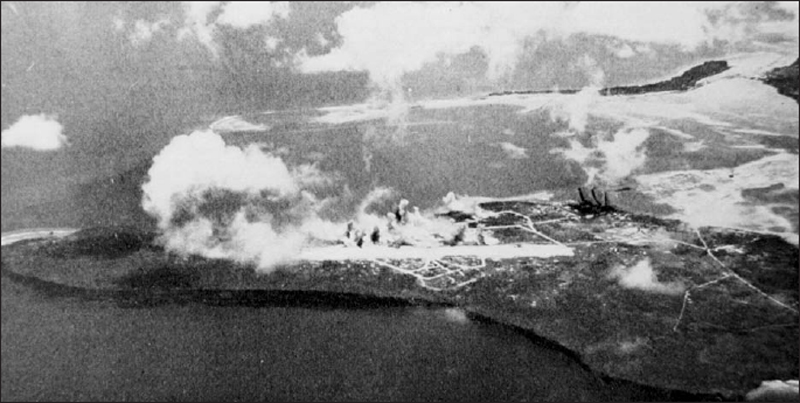
Guam was flailed with the longest pre-landing bombardment to date. Orote Peninsula especially was blasted, as it was known to be a Japanese strongpoint covering the Southern Beaches and Apra Harbor to the north. The Marines aimed to capture the peninsula as early as possible to allow the 3rd MarDiv and 1st Prov MarBde to link-up, and to capture, repair and use its airfield. The white strip of the airfield can be seen in the center. Cabras Island on the north side of Apra Harbor is in the upper right.
Lieutenant-General Takeshi, commanding the 29th Division and Southern Marianas Army Group, established specific defense sectors. The 48th Independent Mixed Brigade (IMB) was assigned to defend the Asan Beaches, with both the 10th IMR and the 29th Division’s 18th Infantry (-) attached in support. The Brigade’s 320th IIB was on the plateau overlooking the Asan Beaches, 321st IIB defended northern Agaña Bay, including Dungcas Beach where the SNLF had come ashore in 1941, and the 322nd IIB secured Tumon Bay further to the north. The 2nd Company, 9th Tank Regiment (2/9 Tank) backed the Brigade at Sinajana. The 48th IMB’s Artillery Unit was scattered across the Agaña area with some guns positioned inland. The 18th Infantry (-) retained control of only its III Battalion defending the harbor. The 38th Infantry was responsible for the Agat Beaches. I/38 Infantry defended the southern portion of Agat Bay and II/38 the northern. Elements of the 54th Guard Force defended the Orote Peninsula along with the 800-man Hyo Unit and the 700-man Genzan Unit formed from the IJN 263rd and 755th Air Groups, respectively. Commander Tamai Asaichi of the 263rd Air Group was responsible for the peninsula’s defense and controlled II/38 at its neck. A mobile reserve was held under the 29th Division behind Fonte Plateau comprised of III/38 Infantry, 319th IIB; 9th Company, III/38 IMR; and 24th Tank Company plus the 400-man Otori Unit, made up of IJN 521st Air Group personnel. The southern end of the island was defended by the 10th IMR. Its III/10 was on the south end spread out between Umatac and Inarajan while II/10 was between Pago and Ylig Bays. II/18 Infantry was at Finaguayac on Guam’s north end.
Regardless of efforts at deception made by the Americans to bombard beaches other than the actual landing sites, the Japanese command was able to identify Asan and Agat Beaches as the most likely targets. Beginning on 8 July the 10th IMR began withdrawing its two battalions from the south of the island and assembled them at Ordat. 9th Company, III/10 IMR was placed in a reserve position near Mt. Alifan to support the 38th Infantry. II/18 Infantry in the north also assembled at Ordat to reinforce the Asan Beaches. The 322nd IIB remained at Tumon Bay.
With shortages of small arms and infantry crew-served weapons for the ad hoc rifle units, little medium artillery, low supplies of AA ammunition, and no hope of air support or reinforcement, the Japanese tactical defense situation was bleak. In addition to relying on the ability of the Combined Fleet to defeat the American invasion fleet, the A-Go Operation counted on land-based aircraft to launch attacks and provide air cover. A total of 14 airfields and two seaplane bases were supposed to be completed in the Marianas by April. Although the seaplane bases were finished, only nine of the airfields were operational. The operational fields could support 400 aircraft, but American air attacks and naval bombardment destroyed all aircraft prior to Saipan’s D-Day. Guam’s 80 fighters and 80 bombers were destroyed on or over the island itself or lost supporting the defense of Biak.
3 Each island was assigned a different letter identifying its assault date to prevent confusion between operations; D-Day for Saipan, J-Day for Tinian, and W-Day for Guam.
4 At the time the assignments were made, IIIAC was designated I Marine Amphibious Corps (IMAC). It was redesignated IIIAC on 15 April 1944.
5 The ridge was named after Captain Geary R. Bundschu commanding A/1/3, who was killed leading his unit to capture the feature.